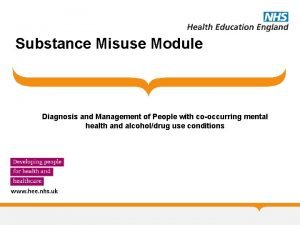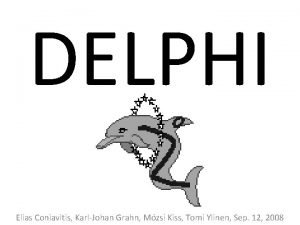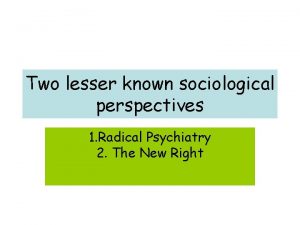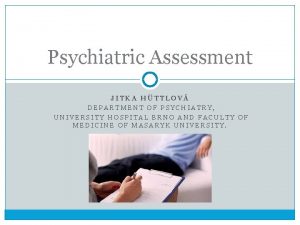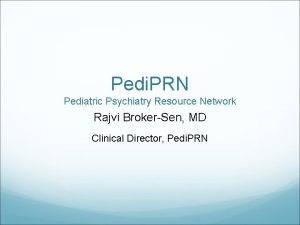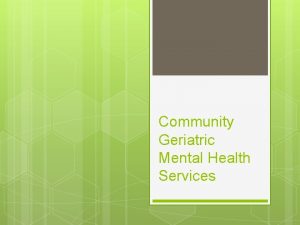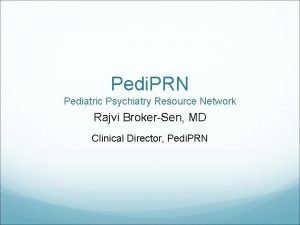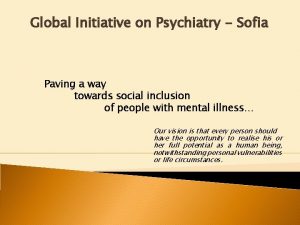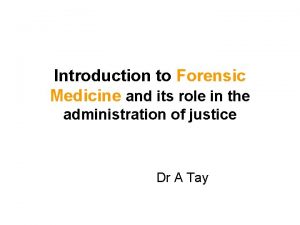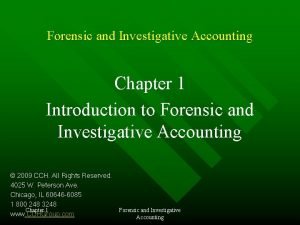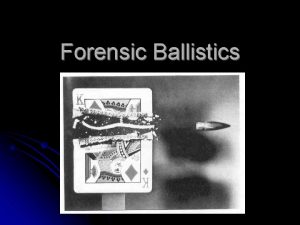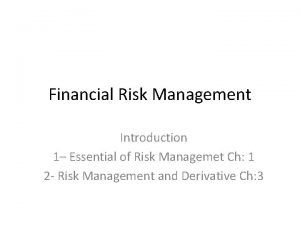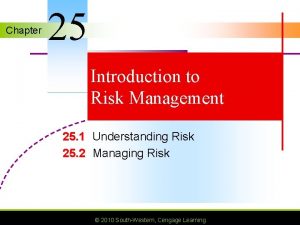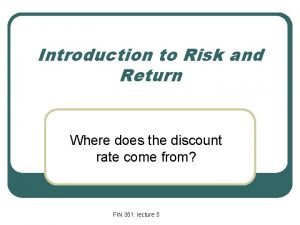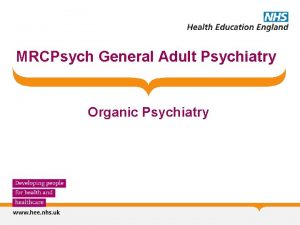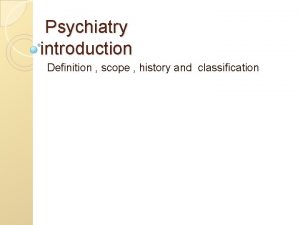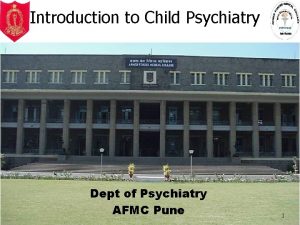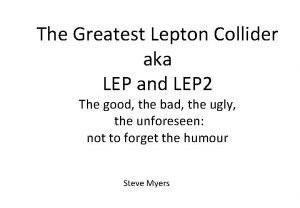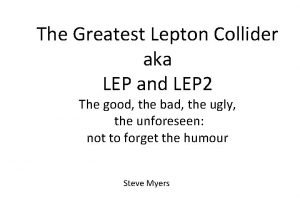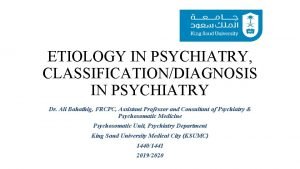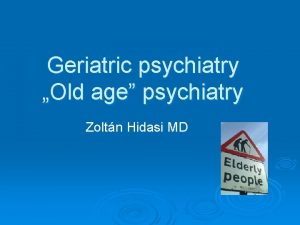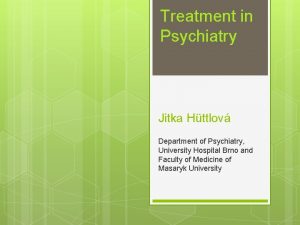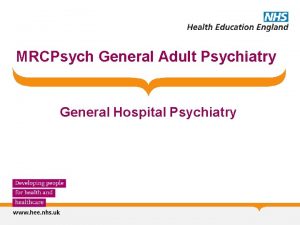Forensic Psychiatry Forensic LEP 4 Introduction to Risk


























































- Slides: 58

Forensic Psychiatry Forensic LEP 4: Introduction to Risk Assessment

Introduction to Risk Assessment Aims and Objectives (from handbook) • To develop an understanding of what clinical risk is • To understand different risk assessment tools • To develop skills in planning how to undertake a risk assessment • To develop skills in risk formulation • To develop an understanding of risk management

Introduction to Risk Assessment To achieve this • • • An introduction to risk Risk assessment tools Forensic clinical interview Risk assessment Risk formulation Risk management • Please sign the register and complete the feedback

Forensic Psychiatry Expert Led Session Introduction to Risk Assessment Authors: Dr Jayne Taylor Dr Victoria Sullivan Dr Caroline Hoult

An introduction to risk

What is Risk? • A statistical term • Relates to a generally negative term • Differs from vulnerability in that it says nothing about causality but is based on factors which suggest an increase in probability of occurrence. • Says nothing about mechanism that bring about event/state.

Clinical Risk • Is an ESTIMATE • Is not just concerned with probability of a behaviour (e. g. violence or self injury) but also - severity? - frequency? - imminence?

Risk of what? • Violence • Vulnerability • Self-injury / Suicide • Financial crimes • Sexual offending • Self-neglect • Fire-setting • Absconding • Relapse • Property damage

Risk Factors static dynamic attitudes stable (chronic) change slowly unchangeable e. g. history or abuse change over time e. g. alcohol acute (triggers) change rapidly

Static Risk Factors • Age • Childhood conduct disorder • Sex • Childhood abuse • Previous violence • Parental criminality • Educational attainment • Socio-economic background • Psychopathic traits • Dissocial PD traits

Dynamic Risk Factors CHRONIC • Substance dependence • Insight • Psychotic symptoms • Victimisation • Justification for violence • Violent thoughts / fantasies ACUTE • Substance misuse • Anger or irritability • Impulsivity • Recent victimisation • Availability of weapons • Availability of victims

Assessing Risk: Unstructured Clinical Approach • Information obtained in ongoing clinical assessment • Not gathered systematically • Inconsistent

Assessing Risk: Actuarial Risk Assessment (ARA) • Focus on static risk factors shown to be statistically associated with increased risk in large samples (e. g. car insurance). • Generates overall score of presumes risk • Emphasis is on prediction not management • Does not provide any information about nuances of risk – does not provide measure of risk in individual user

Examples of ARA tools Psychopathy Checklist Revised (PCL-R) Level of Service Inventory Revised (LSI-R) Static-99 Sex Offender Risk Appraisal Guide (SORAG) Violence Risk Appraisal Guide (VRAG)

Assessing Risk: Structured Clinical (Professional) Judgement • Involves clinician making judgement about risk by combining assessment of defined risk factors derived from research with clinical presentation • Preferred model in health care settings • Risk reduction interventions more possible

Examples of SPJ tools HCR-20 Sexual Violence Risk-20 (SVR 20) Spousal Assault Risk Assessment (SARA) Structured Assessment of Violence Risk in Youth (SAVRY)

Principles of Risk Management • Can never entirely eliminate risk • Management plans should be developed collaboratively by a team and include service user. • Weigh up potential benefits/harm of choosing one action over another. • Should also consider resilience and strength factors

Risk Assessment Interview Skills: Forensic Clinical Interviewing

Risk assessment • Full psychiatric history • Mental state examination • Using a structured risk assessment tool may be helpful to guide assessment – E. g. HCR-20 factors • Need to think about protective factors too

Forensic Clinical Interviewing • Engaging with client in context of legal proceedings to address a specific psycholegal question – E. g. What kind of risk does this person present to others? How restrictive might his community supervision need to be? • Confidentiality limited / non-existent • Coercion

Core Skills • • Interview no-no’s Questioning Style Listening Non-verbal communication Control Note-taking Conclusion

Defence mechanisms • • Splitting Projection Projective Identification Devaluation

Concealment Lying = deliberate attempt to mislead Truthful narratives • • Contextual embedding Reproduction of conversations Unexpected complications Attributions of another’s mental state

Risk Assessment Identifying Risk Factors

Factors Individual Historical / Dispositional Factors Individual Clinical Factors Explanatory or Motivational Factors Situational or Environmental Factors

Individual Historical Factors • • Previous violence Age Educational attainment Psychopathic traits / PD Childhood conduct disorder Childhood abuse Parental criminality Impulsiveness

Previous violence Nature of the violence • Frequency & severity • Use of weapons • Proportionate Situational triggers • Victim types • Emotions, places & people Retrospective attitudes • To victim • Re violence

Individual Historical Factors • • Previous violence Age Educational attainment Psychopathic traits / PD Childhood conduct disorder Childhood abuse Parental criminality Impulsiveness

Individual Clinical Factors • • • Substance misuse Anger & irritability Justification of violence Violent thoughts & fantasies Insight and understanding Collaboration with services

Substance misuse 4 possible relationships between substance misuse and violence in MDOs • Intoxication leads directly to violence • Substance misuse leads to symptoms which leads to violence • Substance misuse and violence linked through other characteristics • Substance misuse leads to socio-economic environment where violence more likely Investigate role of drugs / alcohol in specific episodes of violence

Individual Clinical Factors • • • Substance misuse Anger & irritability Justification of violence Violent thoughts & fantasies Insight and understanding Collaboration with services

Explanatory or motivational factors • • • Persecutory delusions Auditory hallucinations Threat control over-ride symptoms Morbid jealousy Delusional misidentification Negative attitudes

Situational / environmental factors • • Recent victimisation Social network and support Availability / use of weapons Availability of victims

Risk Formulation

Formulation • Underpins clinical practice • Narrative that explains problem and proposed hypotheses for change • Purpose – Organise – Mutual understanding – Intervention – Communication

Formulation • • Explain the behaviour Individualised Diachronic Simple Action-oriented 5 P’s 3 D’s

5 P’s of Formulation Predisposing factors Precipitating factors Problem Perpetuating factors Protective factors

3 D’s of Formulation Drivers Disinhibitors Destabilisers

Risk Management

Risk Management Plan • • • Prevent / limit harmful outcomes Treatment Supervision Monitoring Victim-safety planning Scenario planning

Possible Management Options Treatment Reducing risk factors Enhancing protective factors Improving deficits in function • Address substance misuse • Treating mental illness • Minimise access to weapons • Personal support • Compliance • Therapeutic engagement • Insight • Target maladaptive coping strategies • Structured day / meaningful occupation • Target selfesteem issues

Possible Management options Supervision • • • Treatment in hospital Restriction order effects Monitor and control access to illicit substances Boundaries to minimise impulsivity Structure Occupational therapy

Possible Management options Monitoring • Early warning signs for violence – Psychotic symptoms – paranoia +++ – Quarrelsome – Staff intervention for self-harm – Irritability – Pacing – Threats etc

Possible Management Options Victim Safety Planning • Female partners – domestic violence • Support & monitor contact with victim – ? Non-contact order • Confidentiality

Breaking confidentiality • Information should not be disclosed unless patient consents, except – To protect the patient or others – In connection with judicial / statutory proceedings • Tarasoff Case – Duty to warn third parties of threatened danger

Scenario planning • Kinds of scenarios to plan for – Use of substances – Non-compliance with medication – Arguments – Relationship difficulties – Escalating self-harm – how to support

Further Reading • Baird J & Stocks R. Risk assessment and management: forensic methods, human results. APT 2013, 19 (5), 358 – 365 • CR 150: Rethinking risk to others in mental health services. Final report of a scoping group. June 2008. RCPsych

Introduction to risk assessment MCQs 1. Which of the following is not an actuarial risk assessment tool? A. VRAG B. SAVRY C. Static 99 D. SORAG E. PCL-R

Introduction to risk assessment MCQs 1. Which of the following is not an actuarial risk assessment tool? A. VRAG B. SAVRY C. Static 99 D. SORAG E. PCL-R

Introduction to risk assessment MCQs 2. Which is not a static risk factor? A. Previous violence B. Parental criminality C. Age D. Substance misuse E. Sex

Introduction to risk assessment MCQs 2. Which is not a static risk factor? A. Previous violence B. Parental criminality C. Age D. Substance misuse E. Sex

Introduction to risk assessment MCQs 3. Which of the following are principles of risk management? A. Victim-safety planning B. Supervision C. Scenario-planning D. Treatment E. All of the above

Introduction to risk assessment MCQs 3. Which of the following are principles of risk management? A. Victim-safety planning B. Supervision C. Scenario-planning D. Treatment E. All of the above

Introduction to risk management MCQs 4. Which is not a feature of a truthful narrative? A. B. C. D. Able to give basic details only Able to give context Able to reproduce conversations Able to make comments about another’s mental state E. Able to manage unexpected complications

Introduction to risk management MCQs 4. Which is not a feature of a truthful narrative? A. B. C. D. Able to give basic details only Able to give context Able to reproduce conversations Able to make comments about another’s mental state E. Able to manage unexpected complications

Introduction to risk management MCQs 5. Which is incorrect with regards to the HCR 20? A. Most commonly used risk assessment tool in the UK B. 10 Historical items C. 10 Clinical items D. It is a form of SPJ risk assessment tool E. It includes risk formulation

Introduction to risk management MCQs 5. Which is incorrect with regards to the HCR 20? A. Most commonly used risk assessment tool in the UK B. 10 Historical items C. 10 Clinical items D. It is a form of SPJ risk assessment tool E. It includes risk formulation

Introduction to Risk Assessment Any Questions? Thank you.
 Forensic psychiatry vs forensic psychology
Forensic psychiatry vs forensic psychology Neurosis vs psychosis
Neurosis vs psychosis Ustálené pomenovania
Ustálené pomenovania Clarence valley lep
Clarence valley lep Lep
Lep Lep jules antonini
Lep jules antonini Lep sidney
Lep sidney Eclass ucc
Eclass ucc Lep module
Lep module South east midlands lep
South east midlands lep Lep l
Lep l Tomi lep
Tomi lep Market risk assessment
Market risk assessment Radical psychiatry sociology
Radical psychiatry sociology Mood mse
Mood mse Geriatric psychiatry definition
Geriatric psychiatry definition Mse abstract thinking
Mse abstract thinking Pediatric shelf percentiles
Pediatric shelf percentiles European psychiatry
European psychiatry Psychiatry in ethiopia
Psychiatry in ethiopia Jamaica hospital psychiatry
Jamaica hospital psychiatry Meaning of criminal psychology
Meaning of criminal psychology Addiction medicine expert witness
Addiction medicine expert witness Pediprn
Pediprn Community geriatric psychiatry
Community geriatric psychiatry Core psychiatry
Core psychiatry National network of child psychiatry access programs
National network of child psychiatry access programs Asclepiades father of psychiatry
Asclepiades father of psychiatry Global initiative on psychiatry
Global initiative on psychiatry Pathologist and anthropologist
Pathologist and anthropologist Risk projection attempts to rate each risk in two ways
Risk projection attempts to rate each risk in two ways Risk avoidance
Risk avoidance Relative risk calculation
Relative risk calculation Residual risk and secondary risk pmp
Residual risk and secondary risk pmp Ar = ir x cr x dr
Ar = ir x cr x dr Absolute risk vs relative risk
Absolute risk vs relative risk Activity sheet 3: stock market calculations answer key
Activity sheet 3: stock market calculations answer key Firm risk scorecard
Firm risk scorecard Risk financing transfer adalah
Risk financing transfer adalah The biggest risk is not taking any risk
The biggest risk is not taking any risk Key risk indicators for vendor management
Key risk indicators for vendor management Ar = ir x cr x dr
Ar = ir x cr x dr Business vs financial risk
Business vs financial risk Relative risk and attributable risk
Relative risk and attributable risk Risk map risk management
Risk map risk management Population attributable risk
Population attributable risk Branches of forensic science ppt
Branches of forensic science ppt Introduction to forensic psychology bartol pdf
Introduction to forensic psychology bartol pdf Locard's exchange principle
Locard's exchange principle Forensic science an introduction
Forensic science an introduction Chapter 1 intro to forensic science
Chapter 1 intro to forensic science Introduction to forensic medicine
Introduction to forensic medicine Introduction to forensic accounting
Introduction to forensic accounting Forensic ballistics definition
Forensic ballistics definition Introduction to forensic accounting
Introduction to forensic accounting Essential of financial risk management
Essential of financial risk management A systematic study of the risks that you face.
A systematic study of the risks that you face. Chapter 21 introduction to risk management
Chapter 21 introduction to risk management Introduction to risk and return
Introduction to risk and return








